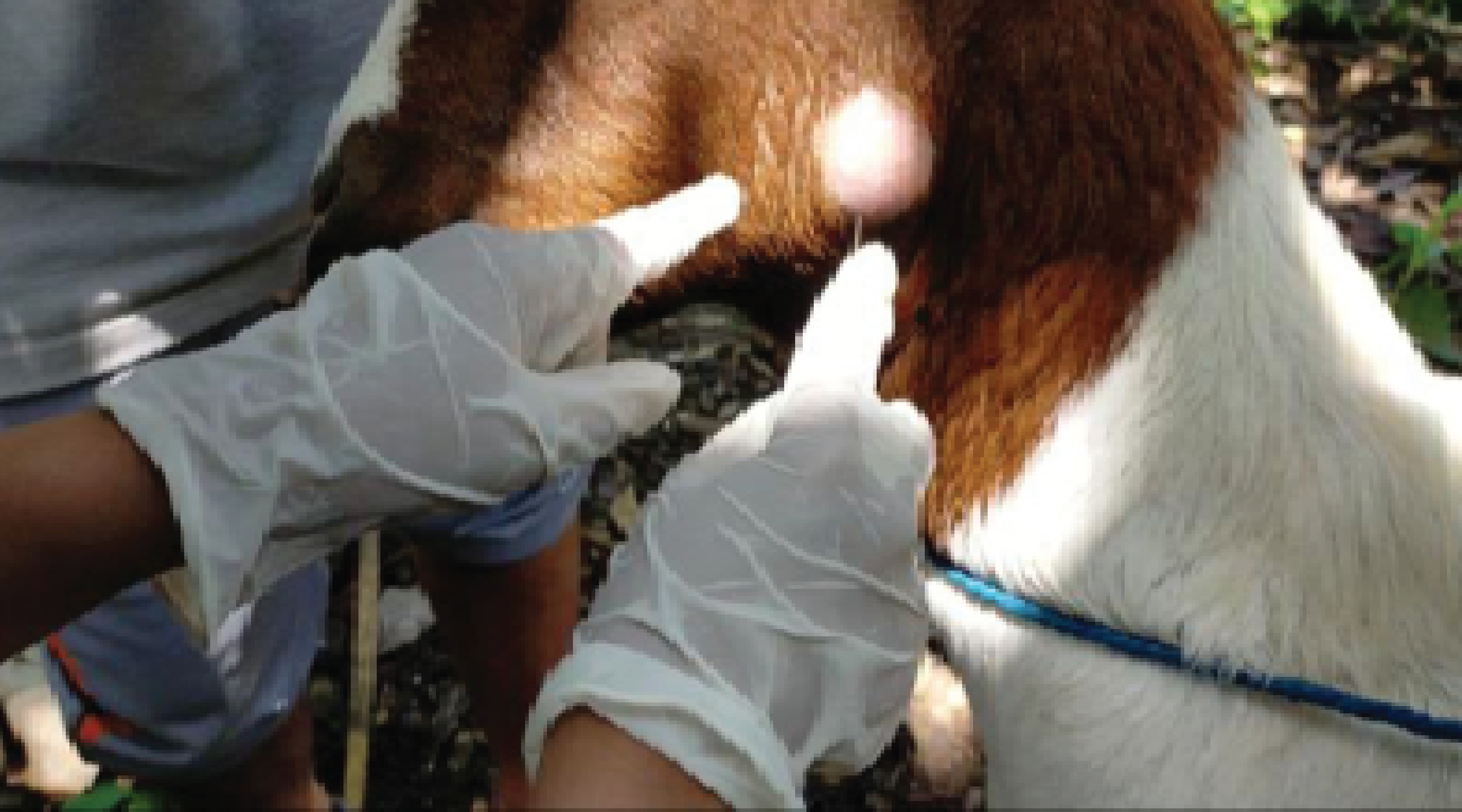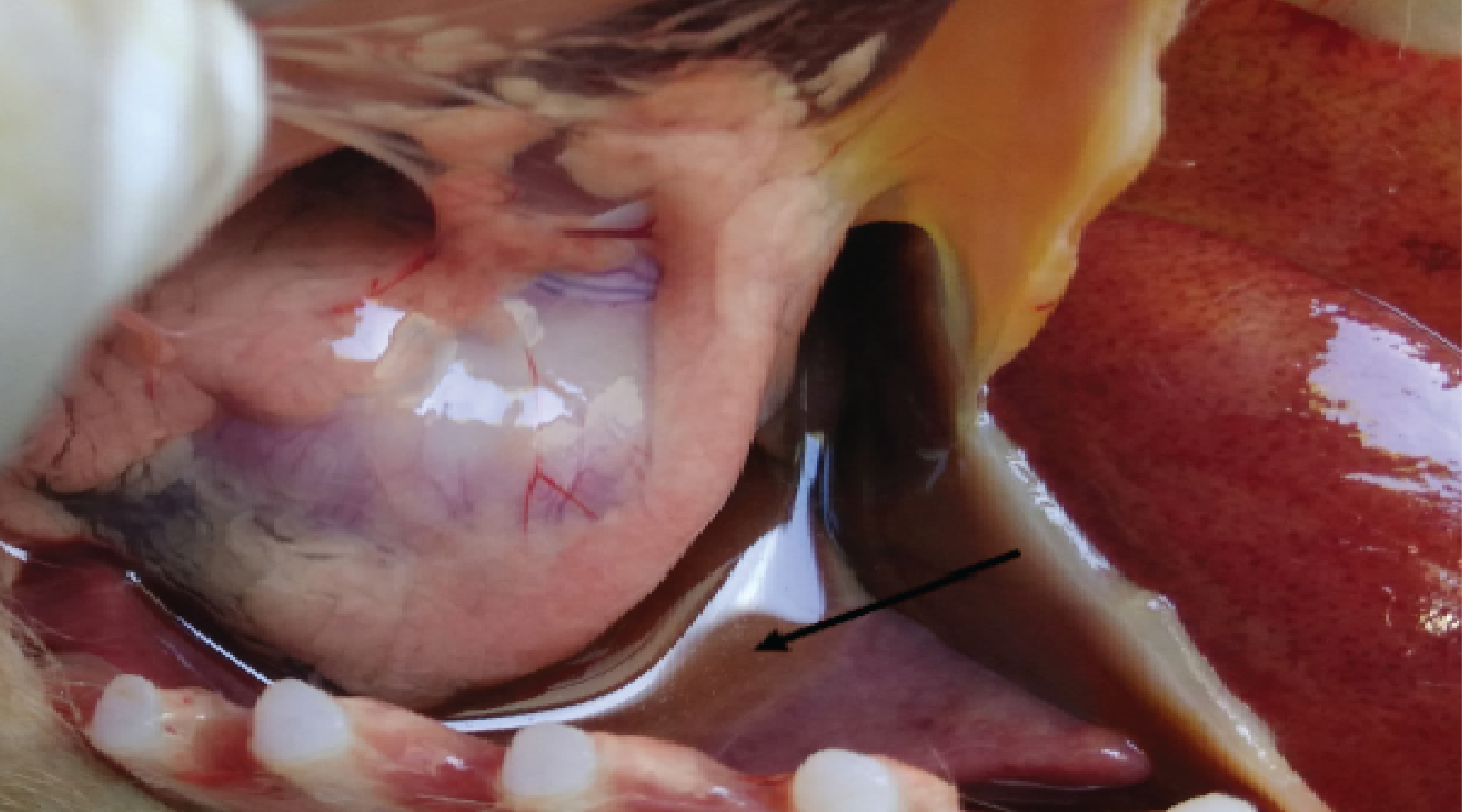Literature Study: Leptospirosis in Dogs 2012-2021 Period

Downloads
Background: Leptospirosis is a zoonotic disease caused by Leptospira interrogans and infects almost all mammals. Purpose: Finding out the correct diagnosis and choosing the best treatment outcome regarding clinical symptom recovery and confirmatory investigations. Method: This literature study compared the percentage of related parameters from 18 cases and discussed 18 cases of dogs infected with leptospirosis with international coverage. Based on the literature, methods for diagnosing leptospirosis in dogs include anamnesis, clinical symptoms, abnormal clinical pathology findings, serological tests such as the Microscopic Agglutination Test (MAT), and molecular diagnostics such as Polymerase Chain Reaction (PCR). Results: Dominant clinical symptom in the digestive system was vomiting (55%), whereas the consistent hematological finding was thrombocytopenia (55.5%), and the consistent blood chemistry finding was elevated BUN (66.6%). Most case studies used the molecular diagnostic method MAT which found positive results (55.5%). Therapeutic management carried out in the case studies included causative treatment of antibiotics (doxycycline, benzylpenicillin, amoxicillin, and enrofloxacin), fluid therapy (crystalloids), antioxidants (vitamin C), mucolytics (N-acetylcysteine), and antiemetics (metoclopramide). The number of patients declared cured was 44.5%, and 55.5% died. Conclusion: The predominant clinical symptoms of leptospirosis are categorized as non-specific, with the largest number being vomit. The dominant method of diagnosis of leptospirosis was obtained from 16 cases using hematology and blood chemistry tests. The therapy is given causatively, namely doxycycline antibiotics, whereas symptomatic signs are resolved using metoclopramide as an antiemetic.
Alinaitwe, L., Kakooza, S., Eneku, W., Dreyfus, A., and Rodriguez"Campos, S., 2017. Case of Clinical Canine Leptospirosis in Uganda. Veterinary Record Case Reports, 5 (4).
Allen, A.E., Buckley, G.J., and Schaer, M., 2016. Successful Treatment of Severe Hypokalemia in A Dog With Acute Kidney Injury Caused by Leptospirosis. Journal of Veterinary Emergency and Critical Care, 26 (6), 837–843.
Ashna, S., Devi, S.S., Sajitha, I.S., Reshma, R.S., and Abraham, M.J., 2019. Acquired Hepatic Encephalopathy due to Leptospirosis in Dog: A Case Report. Journal of Entomology and Zoology Studies, 7 (2), 777–779.
Bonaparte, A., Page, C., and Beeler, E., 2018. Orchitis and Balanoposthitis in a dog with Leptospira interrogans serovar Canicola in Southern California. Veterinary Record Case Reports, 6 (3), 463.
Chirathaworn, C., Inwattana, R., Poovorawan, Y., and Suwancharoen, D., 2014. Interpretation of Microscopic Agglutination Test for Leptospirosis Diagnosis and Seroprevalence. Asian Pacific Journal of Tropical Biomedicine, 4, S162–S164.
Claus, A., Van de Maele, I., Pasmans, F., Gommeren, K., and Daminet, S., 2008. Leptospirosis in Dogs: A Retrospective Study of Seven Clinical Cases in Belgium. Vlaams Diergeneeskd Tijdschr, 77, 259–2563.
Ellis, W.A., 2014. Leptospira and Leptospirosis. 1st ed. New York: Springer.
Etish, J.L., Chapman, P.S., and Klag, A.R., 2014. Acquired Nephrogenic Diabetes Insipidus in A Dog with Leptospirosis. Irish Veterinary Journal, 67 (1), 7.
Geisen, V., Stengel, C., Brem, S., Müller, W., Greene, C., and Hartmann, K., 2007. Canine Leptospirosis Infections - Clinical Signs and Outcome with Different Suspected Leptospira Serogroups (42 cases). Journal of Small Animal Practice, 48 (6), 324–328.
Goldstein, R.E., 2010. Canine Leptospirosis. Veterinary Clinics of North America: Small Animal Practice, 40 (6), 1091–1101.
Greene, C.E., ed., 2012. Infectious Diseases of the Dog and Cat. 4th ed. St. Louis, Mo: Elsevier/Saunders.
Kohn, B., Steinicke, K., Arndt, G., Gruber, A.D., Guerra, B., Jansen, A., Kaser-Hotz, B., Klopfleisch, R., Lotz, F., Luge, E., and Nöckler, K., 2010. Pulmonary Abnormalities in Dogs with Leptospirosis: Leptospirosis in Dogs. Journal of Veterinary Internal Medicine, 24 (6), 1277–1282.
Larson, C.R., Dennis, M., Nair, R.V., Llanes, A., Peda, A., Welcome, S., and Rajeev, S., 2017. Isolation and characterization of Leptospira interrogans serovar Copenhageni from a dog from Saint Kitts. JMM Case Reports, 4 (10), 1–5.
Levett, P.N., Branch, S.L., Whittington, C.U., Edwards, C.N., and Paxton, H., 2001. Two Methods for Rapid Serological Diagnosis of Acute Leptospirosis. Clinical Diagnostic Laboratory Immunology, 8 (2), 349–351.
Loftis, A., Castillo-Alcala, F., Bogdanovic, L., and Verma, A., 2014. Fatal Canine Leptospirosis on St. Kitts. Veterinary Sciences, 1 (3), 150–158.
Major, A., Schweighauser, A., and Francey, T., 2014. Increasing Incidence of Canine Leptospirosis in Switzerland. International Journal of Environmental Research and Public Health, 11 (7), 7242–7260.
Martinez, S.A. and Hostutler, R.A., 2014. Distal Renal Tubular Acidosis Associated with Concurrent Leptospirosis in a Dog. Journal of the American Animal Hospital Association, 50 (3), 203–208.
Mulyani, G.T., Hartati, S., Wuryastuty, H., Tjahajati, I., Yuriadi, Y., Widiyono, I., Yanuartono, Y., Purnamaningsih, H., Indarjulianto, S., Raharjo, S., Nururozi, A., Ganapragasam, A., and Jiao, Y.S., 2019. Identifikasi Serovar Penyebab Leptospirosis pada Anjing di Yogyakarta. Jurnal Sain Veteriner, 37 (2), 227.
Musso, D. and La Scola, B., 2013. Laboratory Diagnosis of Leptospirosis: A Challenge. Journal of Microbiology, Immunology and Infection, 46 (4), 245–252.
Patel, P., Kumari Patel, S., Kumar Verma, N., and Dixit, S.K., 2018. Therapeutic Management of Leptospirosis in a Two Dogs: A Case Report. International Journal of Current Microbiology and Applied Sciences, 7 (03), 2966–2972.
Paz, L.N., Dias, C.S., Carvalho, V.M.P.D., Muramoto, C., Estrela-Lima, A., and Pinna, M.H., 2021. Unusual Case of Polyarthritis and Hepatorenal Syndrome Associated with Leptospira Interrogans Infection in a Dog: A Case Report. Research in Veterinary Science, 134, 186–190.
Plumb, D.C., 2011. Plumb's Veterinary Drug Handbook: Pocket. 7th ed. USA: Wiley-Blackell.
Prasetyo, D. and Pamungkas, K.N.I.N., 2018. Suspect Leptospirosis Pada Anjing Lokal Mix. ARSHI Veterinary Letters, 2 (4), 75–76.
Putro, D.B.W., Ristiyanto, R., Mulyono, A., Handayani, F.D., and Joharina, A.S., 2016. Deteksi Leptospira Patogenik pada Urin Anjing dengan Polymerase Chain Reaction (PCR) di Kota Semarang. Vektora : Jurnal Vektor dan Reservoir Penyakit, 8 (1), 7–12.
Rahman, Md.Z., Hossain, A., Rahman, Md.M., Nasren, S., Al-Mamun, Md.A., Khalil, S.M.I., and Alam, M.M.M., 2021. Molecular Identification of Aeromonas hydrophila Isolate with Sensitivity and Resistance to Antibiotics for its Different Strains. Advances in Animal and Veterinary Sciences, 9 (12), 2062–2068.
Ramsey, I., ed., 2017. BSAVA Small Animal Formulary. Part A, Canine and Feline. 9th ed. Gloucester: British Small Animal Veterinary Association.
Saeki, J. and Tanaka, A., 2021. Canine Leptospirosis Outbreak in Japan. Frontiers in Veterinary Science, 8, 763859.
Samrot, A.V., Sean, T.C., Bhavya, K.S., Sahithya, C.S., Chan-drasekaran, S., Palanisamy, R., Robinson, E.R., Subbiah, S.K., and Mok, P.L., 2021. Leptospiral Infection, Pathogenesis and Its Diagnosis”A Review. Pathogens, 10 (2), 145.
Sangeetha, S.G., Raguvaran, R., Preena, P., Chandrama, R., and Mukherjee, R., 2019. Mixed Infection of Leptospira and Ehrlichia Canis in a Labrador Retriever Dog- a Case Report. Haryana Veterinary Journal, 58 (1), 136–137.
Schuller, S., Francey, T., Hartmann, K., Hugonnard, M., Kohn, B., Nally, J.E., and Sykes, J., 2015. European Consensus Statement on Leptospirosis in Dogs and Cats. Journal of Small Animal Practice, 56 (3), 159–179.
Sessions, J.K. and Greene, C.E., 2004. Canine Leptospirosis: Epidemiology,Pathogenesis, and Diagnosis. Compendium, 26 (8), 606–623.
Sharun, K., Anjana, S., Dhivahar, M., Ambily, V.R., and Pillai, U.N., 2019. Diagnosis and Treatment of Canine Leptospirosis Due to serovar Bataviae”A Case Report. Comparative Clinical Pathology, 28 (6), 1829–1833.
Sykes, J.E., Hartmann, K., Lunn, K.F., Moore, G.E., Stoddard, R.A., and Goldstein, R.E., 2011. 2010 ACVIM Small Animal Consensus Statement on Leptospirosis: Diagnosis, Epidemiology, Treatment, and Prevention: Leptospirosis. Journal of Veterinary Internal Medicine, 25 (1), 1–13.
Copyright (c) 2023 Author(s)

This work is licensed under a Creative Commons Attribution-ShareAlike 4.0 International License.
- The journal allows the author to hold the copyright of the article without restrictions.
- The journal allows the author(s) to retain publishing rights without restrictions.
- The legal formal aspect of journal publication accessibility refers to Creative Commons Attribution Share-Alike (CC BY-SA).

Journal of Applied Veterinary Science and Technology is licensed under a Creative Commons Attribution-ShareAlike 4.0 International License




























